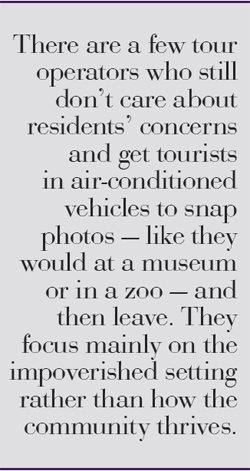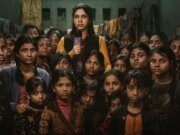
The good, the bad and the ugly of slum tourism.
From the Bronx to Bombay and South America to South Africa, visitors are teeming to watch how the other half lives. Slums in India, townships in South Africa and favelas (shanty towns) in Brazil have become go-to destinations for travellers looking for a new experience. Is slum tourism worth the ethical controversy or is it just plain, brutal poverty voyeurism? Experts clarify why this fastest-growing segment of niche-tourism has been on a controversial journey.
The Rise of Slum Tourism
“The rise of slum tourism can be related largely to a search for exoticism,” says Ko Koens, coeditor of the book Slum Tourism: Poverty, Power and Ethics, who has done extensive research on small tourism businesses involved in township tourism around Cape Town.
“People want to see how the other side lives, without being a part of it,” says Washingtonbased travel psychologist Michael Brein.
“Affording us an opportunity to commune with, and pay it forward to the less fortunate, slum tourism, in a way, helps assuage our sense of guilt too,” he adds.
However, a 2010 study by the University of Pennsylvania stated that tourists visiting the Dharavi slum in Mumbai were motivated mainly by curiosity. One of the reasons behind the rising interest could be films involving slum life. Slumdog Millionaire (Mumbai), City of God (Rio de Janeiro) and District 9 (Johannesburg) caused a stir internationally.
Part of the credit also goes to slum tour marketers who are “attracting tourists eager for an authentic experience by promising an encounter with the real world,” says the U.K. campaigning charity Tourism Concern.
A Global Phenomenon
The tradition of slum tourism is as old as slums themselves. “Tourists visited Victorian London slums and the slums of New York in the 19th century as well,” says Dr. Fabian Frenzel, lecturer at the University of Leicester and visiting research associate at the Centre for Tourism and Cultural Change at Leeds Metropolitan University. In the past 30-odd years, the concept reappeared first in Brazil and South Africa before going global.
Usually, slum tourism occurs in a city where a poor area or township exists along with conventional tourism. Cities like Mumbai, Rio de Janeiro, Johannesburg, New York City and Belfast have the appeal of traditional tourism too.
Conducting Tours to Break Stereotypes
Slum tour operators have seen a jump in their business, and many now are adding township tourism to their list. Quite a few have been credited for their good work. Reality Tours and Travel, which runs slum tours in Dharavi, Mumbai, were the overall winner at the Virgin Holidays Responsible Tourism Awards held in London in 2012. They operate their tours “to change people’s opinions about the area and encourage them to think more complexly about underprivileged communities,” says Stephanie Hays, the CEO of the company. “One of the aims is also to dispel the myth that Dharavi is simply a place of squalour and poverty but to show that in reality, Dharavi, despite its limitations, is different from that,” she adds.
Zezinho da Rocinha, who heads Favela Adventures, a company operated 100% by residents in the favela of Rocinha, says, “I started my tour because I saw in it the opportunity to show my favela and also create jobs for other residents. I have heard other tour companies tell exaggerated stories and tell outright lies about my favela. They do this because they don’t know us and do not live here.”
Are These Tours Intrusive?
The two-pronged controversy behind these tours rejects them as degrading and voyeuristic.
There are a few tour operators who still don’t care about residents’ concerns and get tourists in air-conditioned vehicles to snap photos — like they would at a museum or in a zoo — and then leave. They focus mainly on the impoverished setting rather than how the community thrives.
But operators like Reality Tours and Travel ensure that the tour respects the community. They guide appropriately dressed visitors on foot, in small groups of no more than six or seven, with a very strict no-photography policy. Their guides are either from Dharavi or similar areas, and they constantly train and develop to ensure they have an up-to-date and in-depth understanding of the community and its issues.
Rocinha too takes his visitors through a social experience and educates them about life in his favela.
“In the past seven years, most community members have developed a bond with the guides and are happy to have tourists around,” says Asim Shaikh, a guide with Reality Tours and Travel’s Dharavi tours. Some of their business thrives when tourists buy water, soft drinks and confectionary during their visits. They also like interacting with foreigners in English.”
“When foreigners visit, I feel like my favela has value. We want our voice to be heard and to feel that somebody on the outside cares for and recognizes our existence,” Rocinha says on behalf of the residents of his favela.

Frenzel’s research on favelas suggests, “Slum dwellers don’t tend to find tours intrusive.”
But there are occasions when residents do get offended. “What they don’t like is when tourists (apart from those who come with tours) barge into the community with their taxis, click photos and hold their noses if they sense a bad smell,” Shaikh says.
Irfan Memon, a 37-year-old Dharavi resident, feels that all tourists are guests to his community and should be respected. “There are a few people though,” he says, “who have an objection to tourists.”
“Most people who take slum tours are foreigners who just come here to see how community members battle with poverty in their daily lives,” says Jockin Arputham, president of Slum Dwellers International, who considers slum tours to be a form of exploitation.
“The glamorization of violence is something that we do not like here,” Rocinha says. He says tourists need to understand that “favelas are not war zones and that real, honest hardworking people live here. We just make less money.”
Are These Tours Working Economically?
The second point of contention with slum tourism is that despite all the promises, most of these operators don’t give back enough to the community. Tourism Concern, is developing a series of tips for tourists to help them identify better tours, which will be available on their website at www.tourismconcern.org.uk.
“One of the main objectives of our Dharavi tour is to raise money for the activities of our sister NGO, Reality Gives, which runs and supports over 10 programs that would not be possible without the money gained from our Dharavi and city tours,” says Hays of Reality Tours and Travel. The company spends 80 per cent of its post-tax profits on supporting Reality Gives.
The projects Reality Gives runs include a cricket program, a soccer program for girls and acupuncture. These programs were started by past visitors inspired by their Dharavi visits.
Rocinha’s tours have made a difference too. “About 20 per cent [of tourists] return to volunteer in social projects or start their own programs in the favela. Recently people have contacted me wanting to contribute towards a rooftop garden class and another person wants to help bring solar energy here,” he says.
But in a community so large, how many can benefit? “The income produced by slum tourism will never be big enough to provide livelihoods for but a few people in the visited slums,” Frenzel says.
Inspiring Compassion
If not much else, slum tours at least help visitors understand poverty. Tourgoer Paul Wilke from California says his slum tour wiped away his preconceived ideas about Dharavi. “The tour opened my eyes . . . [Dharavi] was a bustling community in itself,” he says. Nancy Katyal from Mumbai learned to be thankful for what she had after a visit to the slums.
“Tours also give a voice to the residents who are often denied such a thing,” Koens adds. “If we listen, we can learn a lot about their perspectives.”
“International tourism has also amplified globally some of the struggles favela residents face in the light of Brazilian World Cup preparations,” Frenzel says.
BY PRITI SALIAN
COMMENTS
YOU MAY ALSO LIKE
Newsletter Sign Up
Subscribe to our FREE newsletter for all of the latest news, articles, and videos delivered directly to your inbox each day!

















































































































